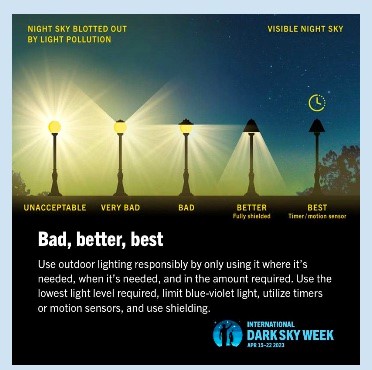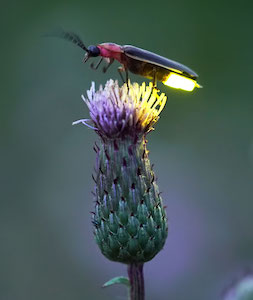Artificial Light at Night Leads to Plant, Pollinator Decline
Illuminating Solutions To Reduce Sky Glow
by Christina Tyler Wenks, Fairfax Master Gardener
Light pollution impacts the health of wildlife, pollinators, plants and humans, but residents can take simple steps to reduce a problem that is increasing as much as 10 percent each year.

International Dark Sky Association suggestions to reducing night light
Illuminated landscapes are a distinguishing characteristic of industrialization and cover much of the Earth’s surface, but life evolved to need hours of darkness. Exposure to artificial light at night can disrupt organisms’ physiological processes with implications for health and conservation and contributes to the decline of some plant and pollinator populations.
Lights allow longer work, play, productivity and make people feel safer, but the problems caused by excessive lighting are far reaching — even into space. Pockets of purely natural light are becoming the exception, not the rule. Just as cooperative extension agents and certified master gardeners suggest the “right plant in the right place,” one solution to light pollution and subsequent sky glow could be as simple as right light at the right time pointed in the right direction.
Earth is transitioning from nighttime to lighttime
More than one-third of the world’s population, which includes 80 percent of the United States population, cannot see the Milky Way or constellations due to artificial light at night, also known as ALAN, which is caused by house and street lights, vehicles and commercial lighting. Disappearing night sky has health consequences to nocturnal wildlife, pollinators and plants as well as human mental health.
LED-lighting provides less expensive and brighter, intense-white lighting, which stimulates the popularity growth of upward aesthetic landscaping lighting with light directed at foliage and structures. Extra light traveling up into the night sky contributes to sky glow, which appears brighter under reflective nighttime clouds.
“Artificial light changes the circadian rhythm of beings and is a type of climate change that is controllable and reversible,” says Eileen Kragie of Dark Sky Friends, a nonprofit based in Fairfax County, Virginia, dedicated to educating about the impact of light pollution and light trespass and how to reverse it.
A newly opened exhibit at the Smithsonian’s Natural History Museum called “Lights Out: Recovering our Night Sky” illuminates the perils of sky glow as well as solutions to reverse ALAN without diminishing visibility or safety. The timing of the exhibit at the Natural History Museum on the National Mall in Washington, D.C., coincides with emerging and growing research about exposure to artificial light at night disrupting organisms’ physiological processes with implications for health and conservation.
Plants, pollinators, predators and prey
Plants and trees depend on light wavelength or color, light intensity or brightness, and hours of light duration to govern photosynthesis that requires visible blues and reds to stimulate sugar production. A plant’s photoperiodism, caused by red and infrared light, controls vegetative and reproductive activities, which is why artificial light at night can cause plants to leaf out instead of flower or fruit.

Photinus pyralis firefly
ALAN impacts the food web in unprecedented and unpredictable ways and is blamed as a cause for the population decline of fireflies that are attracted to any form of light. Fireflies or lightning bugs live underground for years before emerging above ground and using bioluminescence to attract a mate. Most active at dusk and just after dark, males in the treetops fly down to the females that flash, flicker or glow just above the ground. ALAN confuses lightning bugs.
Increasing artificial light around plants that open solely at night or are pollinated by nocturnal pollinators like bugs, birds and bats, decreases or prohibits plants from flowering and reproducing, which impacts plant reproduction and pollinating species, too.
Nighttime croaking is part of the breeding ritual of frogs and toads. Artificial light disrupts nocturnal activity, interfering with reproduction and reducing populations.
Caterpillars often use the guise of night to feed and avoid predation. Insects at all life stages and aquatic organisms caught in artificial light become late-night snacks, reducing populations and impacting long-term sustainability.
Research finds predatory arthropods such as spiders are disproportionately represented in illuminated habitats, and owls are adapting to artificial lighting and nesting nearer to night lights to extend successful foraging time, but the absence of dark is consequentially foul for fowl health, too.

Window light, barred owl eats bugs
During an April 2023 Smithsonian Institution webinar called “Lights Out: the Effects of Light Pollution on Bird Health,” biologist Biologist Valentina Alaasam discussed her ongoing research examining the effects of light pollution on the health of birds and what that research demonstrates about animals adapting to an environment where more light at night is the new normal. Alaasam’s research showed that birds are less likely to nest in trees above yard lights and birds try to nest in darker spaces. In urban and suburban areas, birds have fewer dark choices and nest where they must.
Her research shows that birds subjected to light pollution all night for weeks had enlarged hearts, an effect she said is comparable to heart disease in humans, and young birds are developmentally impacted, too. But, she said her team’s research shows that negative health symptoms caused by all-night light can be reversed within a few weeks when birds return to nesting in all-night darkness. The research parallels studies about human sleep patterns and behaviors and further research is underway.
Research shows that the type of light impacts the amount of nighttime predation and health consequences. Energy-efficient LEDs can create a much brighter, sharper, white light compared to the low-pressure yellow-orange glow of older streetlights, but newer LEDs offer adaptive options such as adjusting color and intensity that can add additional efficiency and appliance longevity and, if used optimally, can be part of respectful night light that coincides with energy cost savings.
Regaining the night requires community involvement
To regain dark skies, respect Native American cultures, to support astro-tourism, and the health of all beings, Tucson, Arizona, leaders made a city-wide lighting retrofit that can be applied anywhere in the world. Down-facing, directional, energy-efficient LED-based lighting saves the city thousands in electricity. Tucson optimized lighting-color temperatures to warm hues specific for different periods of night, operating LED lights at 60 to 90 percent intensity, resulting in energy cost savings.
The City of Alexandria, Virginia, is committed to deliberate, directional lighting endeavors, too, and in a 2023 Dark Sky Proclamation detailed the city’s intent to protect neighborhoods adjacent to stadium lighting from light trespass, too.
Virginia leads the nation in proclamations supporting dark skies with state and municipal support from Arlington, Falls Church, Vienna, Leesburg, Lexington, Ashland and more.
Fix light pollution with four Rs
National Public Radio reports that light pollution is increasing 10 percent every year, but researchers assert that humans can reverse the trend.
Simple, immediate solutions include:
- Reduce light at night by using the least amount only where and when needed and remove redundant lighting. Lights should be turned off or dimmed during off-peak hours to avoid continuous lighting of trees, which has the greatest potential for upsetting normal growth patterns. While shade trees can mitigate light pollution, trees and wildlife in trees are affected by ALAN. Where night lighting already exists, select plantings with low sensitivity to light. Use dimmers, timers and motion sensors.
- Replace blue and white light with warmer lights that may have less light intensity. Use timers and sensors that turn on/off lights.
- Re-direct amounts of light by using lamp covers or directional lighting fixtures facing the ground to reduce light spilling up into the night sky to prevent light pollution avoiding blinding glare. Researchers and Dark Sky Association members recommend avoiding all upward lighting and shining light over horizontal distances.
- Research is ongoing and needed.
Alaasam said that reducing the amount of light from urban commercial and suburban home windows by 50 percent can reduce the number of bird collisions into buildings because of disorienting light at night.
Technology aids adapting lighting, color and intensities where and when needed. The right color and intensity of light at the right time pointed in the right direction creates the right light at night.
Resources
• Lights Out: the Effects of Light Pollution on Bird Health, Smithsonian Institution, webinar, April 12,
2023
• Lights Out: Recovering Our Night Sky Exhibition, Smithsonian Natural History Museum
• Planet Positive Worldwide Lights Out Program, Smithsonian Magazine
• All Things Considered, Light pollution frustrates astronomers looking for discoveries, National Public
Radio (NPR),
• A review of the effects of artificial light at night in urban areas on the ecosystem level and the
remedial measures, Frontiers
• Light pollution harms plants in the environment, Florida Atlantic University
• Light Pollution Effects on Wildlife and Ecosystems, International Dark Sky Association